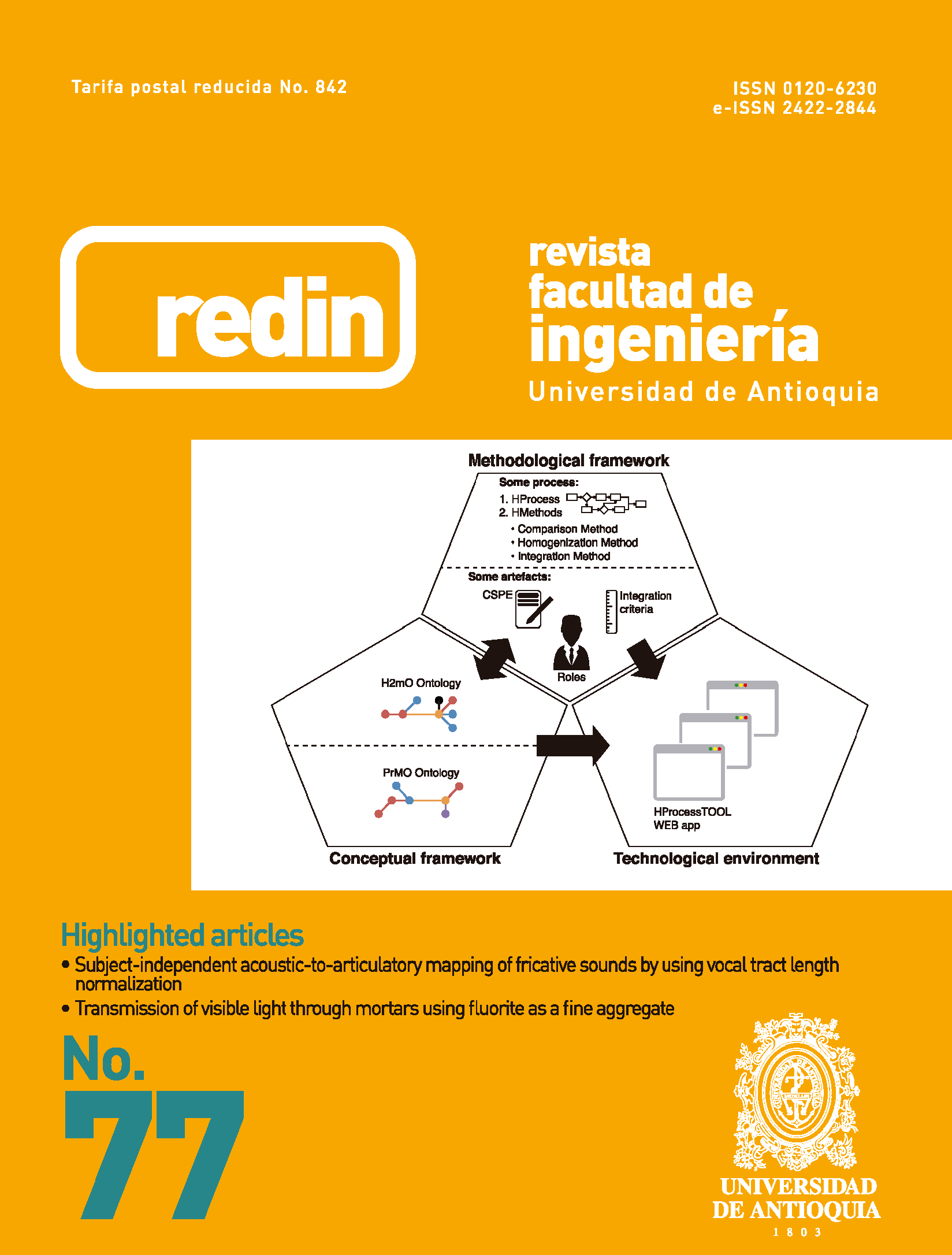Ingeniería de requisitos basada en conocimiento: un estudio comparativo de la estrategia KMoS-RE y el proceso DMS
DOI:
https://doi.org/10.17533/udea.redin.n77a11Palabras clave:
gestión de conocimiento, conocimiento tácito, ingeniería de software empírica, ingeniería de requisitosResumen
Actualmente la gestión de conocimiento tácito, información valiosa que por alguna razón permanece oculta a los desarrolladores, es un problema que enfrentan las compañías de desarrollo de software en la elicitación y descubrimiento de requisitos. Este problema ocasiona que los productos fi nales no cumplan con las expectativas y necesidades de los clientes y/o usuarios. La Estrategia de Ingeniería de Requisitos Basada en Conocimiento (KMoS-RE por sus siglas en inglés) fue diseñada especialmente para encarar este problema y obtener un documento de especifi cación lo más cercano a las necesidades de los clientes y/o usuarios. Este artículo presenta el diseño y los resultados preliminares de un estudio empírico que compara la estrategia KMoS-RE con el proceso de elicitación de requisitos propuesto por MoProSost: Modelo de Procesos de Software orientado a la industria de software en México. Los resultados preliminares muestran que la estrategia KMoS-RE es más adecuada que el proceso de elicitación de requisitos propuesto por MoProSoft.
Descargas
Citas
L. McLeod and S. MacDonell, “Factors that affect software systems development project outcomes: A survey of research”, ACM Computing Surveys (CSUR), vol. 43, no. 4, pp. 24-56, 2011.
S. Hansen, N. Berente and K. Lyytinen, “Requirements in the 21st century: Current practice and emerging trends”, in Design requirements engineering: A tenyear perspective, 1st ed., K. Lyytinen, P. Loucopoulos, J. Mylopoulos and W. Robinson (eds). Cleveland, USA: Springer, 2009, pp. 44-87.
L. Pilat and H. Kaindl, “A Knowledge Management Perspective of Requirements Engineering”, in 5th International Conference on Research Challenges in Information Science (RCIS), Guadeloupe, France, 2011, pp. 1-12.
A. Distanont, H. Haapasalo, M. Vaananen and J. Lehto, “The engagement between knowledge transfer and requirements engineering”, International Journal of Management, Knowledge and Learning, vol. 1, no. 2, pp. 131-156, 2012.
M. Polanyi, The tacit dimension, 1st ed. Garden City, USA: Doubleday, 1966.
R. Gacitua et al., “Making Tacit Requirements Explicit”, in 2nd International Workshop on Managing Requirements Knowledge (MARK), Atlanta, USA, 2009, pp. 40-44.
K. Olmos and J. Rodas, “KMoS-RE: knowledge management on a strategy to requirements engineering”, Requirements Engineering Journal, vol. 19, no. 4, pp. 421-440, 2014.
P. Bresciani, A. Perini, P. Giorgini, F. Giunchiglia and J. Mylopoulos, “Tropos: An Agent-Oriented Software Development Methodology”, Autonomous Agents and Multi-Agent Systems, vol. 8, no. 3, pp. 203-236, 2004.
R. Darimont and A. Lamsweerde, “Formal Refinement Patterns for Goal-Driven Requirements Elaboration”, ACM SIGSOFT Software Engineering Notes, vol. 21, no. 6, pp. 179-190, 1996.
I. Jureta, A. Borgida, N. Ernst and J. Mylopoulos, “Towards a New Generation of Requirements Modeling Languages with Goals, Preferences, and Inconsistency Handling”, in 18th IEEE International on Requirements Engineering Conference, Sydney, Australia, 2010, pp. 115-124.
H. Oktaba, “MoProSoft®: A Software Process Model for Small Enterprises”, in 1st International Research Workshop for Process Improvement in Small Settings, Pittsburgh, USA, 2006, pp. 93-101.
Dines Bjørner, “Rôle of domain engineering in software development. Why current requirements engineering is flawed!”, in 7th International Andrei Ershov Memorial Conference on Perspectives of Systems Informatics (PSI), Novosibirsk, Russia, 2009, pp. 2-34.
G. Hadad, “Uso de escenarios en la derivación de software”, Ph.D. dissertation, National University of La Plata, La Plata, Argentina, 2008.
L. Ma, B. Nuseibeh, P. Piwek, A. Roeck and A. Willis, “On presuppositions in requirements”, in 2nd International Workshop on Managing Requirements Knowledge (MARK), Atlanta, USA, 2009, pp. 27-31.
M. Mitri, “Applying tacit knowledge management techniques for performance assessment”, Computers & Education, vol. 41, no. 2, pp. 173-189, 2003.
I. Nonaka and H. Takeuchi, “The knowledge-creating company: how japanese companies create the dynamics of innovation”, Hardvard Business Review, vol. 69, no. 6, pp. 96-104, 1995.
P. Runeson and M. Höst, “Guidelines for conducting and reporting case study research in software engineering”, Empirical Software Engineering, vol. 14, no. 2, pp. 131-164, 2009.
Descargas
Publicado
Cómo citar
Número
Sección
Licencia
Derechos de autor 2015 Revista Facultad de Ingeniería Universidad de Antioquia

Esta obra está bajo una licencia internacional Creative Commons Atribución-NoComercial-CompartirIgual 4.0.
Los artículos disponibles en la Revista Facultad de Ingeniería, Universidad de Antioquia están bajo la licencia Creative Commons Attribution BY-NC-SA 4.0.
Eres libre de:
Compartir — copiar y redistribuir el material en cualquier medio o formato
Adaptar : remezclar, transformar y construir sobre el material.
Bajo los siguientes términos:
Reconocimiento : debe otorgar el crédito correspondiente , proporcionar un enlace a la licencia e indicar si se realizaron cambios . Puede hacerlo de cualquier manera razonable, pero no de ninguna manera que sugiera que el licenciante lo respalda a usted o su uso.
No comercial : no puede utilizar el material con fines comerciales .
Compartir igual : si remezcla, transforma o construye a partir del material, debe distribuir sus contribuciones bajo la misma licencia que el original.
El material publicado por la revista puede ser distribuido, copiado y exhibido por terceros si se dan los respectivos créditos a la revista, sin ningún costo. No se puede obtener ningún beneficio comercial y las obras derivadas tienen que estar bajo los mismos términos de licencia que el trabajo original.










 Twitter
Twitter